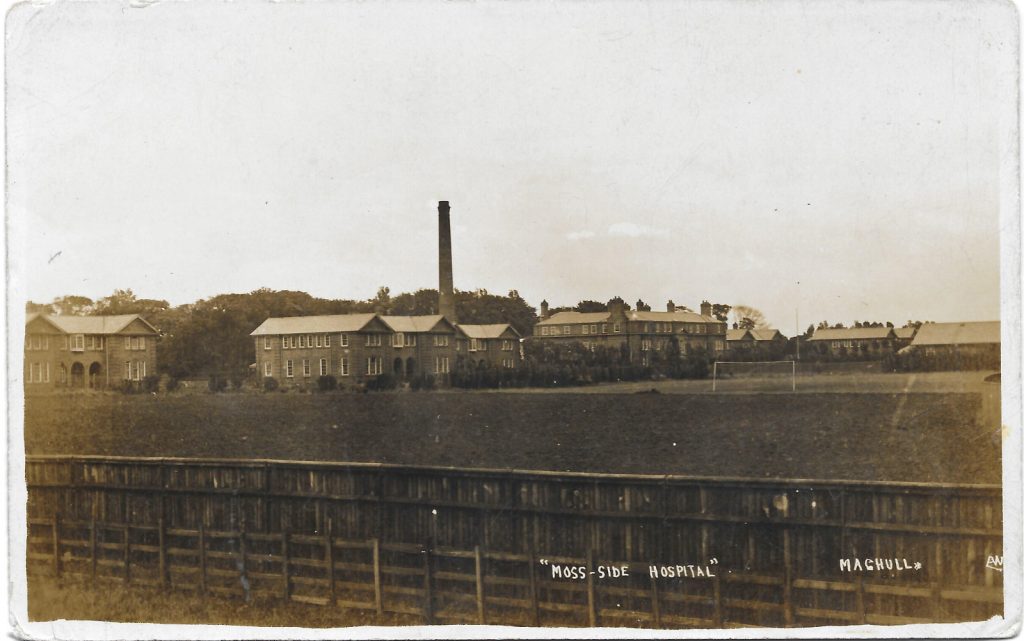“…the partly-demented poor fellow…”
On Wednesday 9th June 1915 the Moss Side Hospital visitors’ book records a visit to Private G. Howe from his brother Mr F. Howe whose address is given as Northfield, Wymondham, Norfolk. (The writing looks like it says “Wyndham” but there is no such place in Norfolk.)
On the night after his brother’s visit, according to the Ormskirk Advertiser of 17th June, George Howes (not Howe) of the Norfolk Regiment escaped from the hospital. The report continued:
“It is supposed that the soldier, whose nerves are affected as the result of his war experiences, was wondering about all Thursday night, but about half-past nine he was observed in a field not far from the Melling Pottery … When he noticed his whereabouts were discovered the partly-demented poor fellow dashed away towards the canal and threw himself into the water close to the Pottery bridge.”
This bridge and the Melling Pottery were situated next to The Horse and Jockey pub. Fortunately an employee of the pottery called James Nattocks jumped in after him and “was able to effect a rescue”. George was then “taken care of by the guard, and later returned to hospital.”
Howes is a common name in Norfolk, and particularly so in the Wymondham area. In the 1911 census there are some thirty dwellings at Northfield, the address that Mr F. Howes gave when he visited his brother George. Three of those thirty properties are occupied by a different Howes family. None of the nine men called Howes who lived on Northfield in 1911 were called George or had a first name beginning with “F”. James Walter Howes and his wife Elizabeth did have a son called George Albert, born 1882, but he had married in 1904 and was living in nearby Damgate Street, with his wife Edith Mary. None of his brothers – James, John and Harry – had a first name beginning with F. There were, however, two men called George Howes living in the vicinity who both had a brother called Frederick.
The first was born circa 1886 in the neighbouring parish of Hethersett to agricultural worker Charles Howes and his wife Mary Ann. This couple raised six sons and two daughters, all of whom were born in Hethersett. George was their third son, and he was followed, about a year later, by Frederick William.
This George Howes was a coach smith before the war, Frederick was an apprentice coach smith, and their two older brothers Maurice and Charles worked in the same trade.
These two brothers cannot be completely discounted, but there were another pair of brothers called George and Frederick Howes who were both born in Wymondham itself, and seem more likely to be the men who met in Moss Side in June 1915.
They were also the sons of an agricultural labourer. William Howes and his wife Mary Ann (nee Nelson) had George around 1884 and Frederick around 1887. By 1891 their family included three more brothers – John, William and Walter – and a sister called Laura. Another sister, Harriet Elsie, was born in 1893.
In the 1891 census the Northfield address doesn’t exist, but comparing the names on the above page with the page in the 1911 census that contains the Northfield addresses we find several of the same families. There are two called Howes and the names Clabburn, Bartram and Farrow also feature on both pages. It seems very likely that they refer to the same properties twenty years apart, which means that this George and Fred Howes grew up on Northfield and had family connections to the address that could easily have resulted in Frederick returning to live there between 1911 and 1915.
By 1901 George’s father was still living with four of his children between two sets of Bartrams and next-door-but-one to the Clabburns. But his mother had died in the early weeks of the year, and George himself was now living with his older sister Laura and her inn-keeper husband Arthur in a pub on Station Road, Wymondham.
Ten years later George’s dad was dead and his children had scattered. It was Elsie, the youngest, who was now living with Laura and Arthur, at the Wagon & Horses pub in Norwich. Fred was a market gardener living just a few hundred yards from Northfield in Pople Street with his wife Eliza and their ten-month old daughter. Just around the corner from Fred two of his three older brothers were lodgers in different properties on Folly Road. William was a gardener living with the Kerry family; George was 27, single, and a general labourer lodging with an elderly couple called Edwards.
But George’s youngest brother Walter was a 22-year old soldier in 1911. He was away in India & Ceylon with the 2nd Battalion Norfolk Regiment.
George must have followed Walter’s example because by the time war broke out in 1914 he too was in the army. His story is continued in part 2 of this blog post.
Written by John Fay
Edited by Amy Walling, Manchester Metropolitan University
Posted on 17 August 2018 under Moss Side Military Hospital







